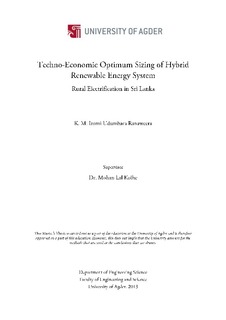| dc.description.abstract | Using an off grid hybrid renewable energy-based power systems for rural electrification has become an attractive solution for areas where grid electricity is either not feasible or the cost of the grid extension is relatively high. A hybrid system uses one or several renewable energy technologies as primary energy sources and a conventional fossil fuel-based or biofuel-based generator as a backup source. Therefore, a hybrid system reduces the dependence on one energy source, resulting in reliable and affordable electricity for the rural consumers. As hybrid systems use several energy technologies, the selection of proper technologies and optimum sizing of the selected components is important in reducing the overall cost and increasing the reliability and availability of the service.
The objective of this study has been to find the optimum configuration of a hybrid system which can supply electricity to a rural community in Sri Lanka. A rural village from the Siyambalanduwa region in Sri Lanka containing approximately 150 households which results in a daily electricity demand of 270 kWh with a night-time peak of 25 kW has been chosen as target. The Siyambalanduwa region receives an abundance of solar radiation with an annual average of 5.0 kWh/m2/day. In addition, the annual average wind speed of this region is 6.3 ms-1 which results in a wind power density of 300 W/m2 at a height of 50 m above the ground. Several electricity generating technologies, including solar, wind and diesel generators have been studied, and the simulations have been performed for a large number of system configurations using the “HOMER” software. The total net present cost of each system configuration has been calculated for 20 years of systemic lifetime in order to examine the lowest energy cost option.
It has been found that the combination of wind turbines, PV system, a battery bank and a diesel generator gives the optimum hybrid system with following the rated capacities, wind – 40 kW, PV – 30 kW, battery bank – 222 kWh and the diesel generator – 25 kW. The wind turbines generate 67 % of the total annual energy output, which is approximately 116000 kWh/yr. The diesel generator is required to provide only 9 % of the total generation, resulting in 1240 hours of operation annually. The remaining 24 % is generated by the PV system. This hybrid system can supply electricity at an approximate levelized cost of 0.3 $/kWh and may be further reduced to 0.2 $/kWh, if state subsidies become available for covering 40 – 50 % of the capital investment. It has also been found that the optimized system can meet the energy demand without change in the energy cost of more than 0.1 $/kWh, even though the annual average wind speed varies in the range of 4.5 – 6.3 ms-1. Consequently, the impact of the energy cost for changes in the annual average solar radiation in the range of 4.0 – 5.5 kWh/m2/day has been found to be negligible. The analysis has also been done by assuming that the national grid will be extended to the rural community after 10 years of off-grid operation. It has been found that the hybrid system is economically viable whether it is operated as off-grid or grid connected. | no_NO |
